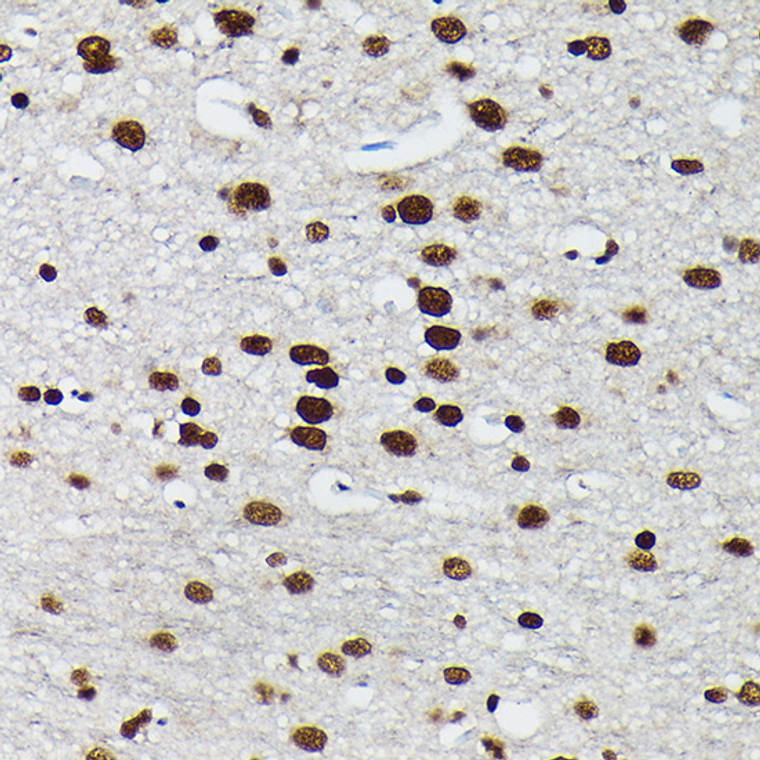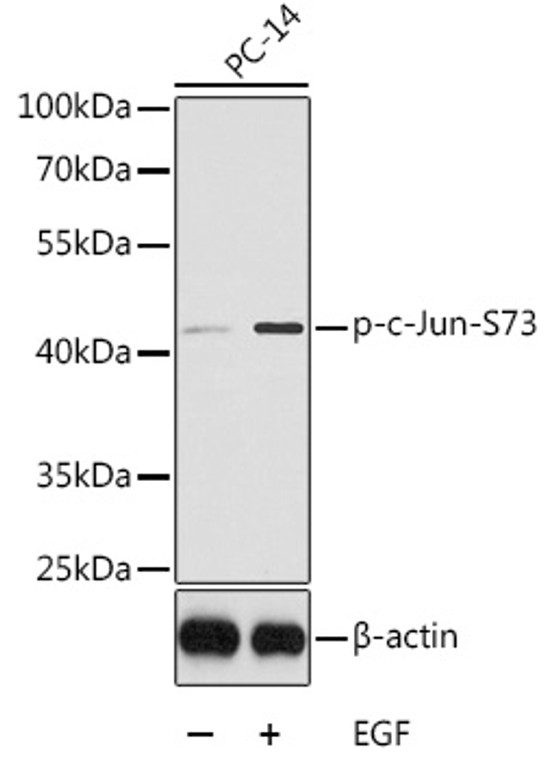| Host: |
Rabbit |
| Applications: |
WB/IHC |
| Reactivity: |
Human/Mouse/Rat |
| Note: |
STRICTLY FOR FURTHER SCIENTIFIC RESEARCH USE ONLY (RUO). MUST NOT TO BE USED IN DIAGNOSTIC OR THERAPEUTIC APPLICATIONS. |
| Short Description: |
Rabbit polyclonal antibody anti-Phospho-c-JUN-S73 is suitable for use in Western Blot and Immunohistochemistry research applications. |
| Clonality: |
Polyclonal |
| Conjugation: |
Unconjugated |
| Isotype: |
IgG |
| Formulation: |
PBS with 0.01% Thimerosal, 50% Glycerol, pH7.3. |
| Purification: |
Affinity purification |
| Dilution Range: |
WB 1:500-1:1000IHC-P 1:50-1:200 |
| Storage Instruction: |
Store at-20°C for up to 1 year from the date of receipt, and avoid repeat freeze-thaw cycles. |
| Gene Symbol: |
JUN |
| Gene ID: |
3725 |
| Uniprot ID: |
JUN_HUMAN |
| Immunogen: |
A synthetic phosphorylated peptide around S73 of human c-JUN (NP_002219.1). |
| Immunogen Sequence: |
LASPE |
| Tissue Specificity | Expressed in the developing and adult prostate and prostate cancer cells. |
| Post Translational Modifications | Ubiquitinated by the SCF(FBXW7), leading to its degradation. Ubiquitination takes place following phosphorylation, that promotes interaction with FBXW7. Phosphorylated by CaMK4 and PRKDC.phosphorylation enhances the transcriptional activity. Phosphorylated by HIPK3. Phosphorylated by DYRK2 at Ser-243.this primes the protein for subsequent phosphorylation by GSK3B at Thr-239. Phosphorylated at Thr-239, Ser-243 and Ser-249 by GSK3B.phosphorylation reduces its ability to bind DNA. Phosphorylated by PAK2 at Thr-2, Thr-8, Thr-89, Thr-93 and Thr-286 thereby promoting JUN-mediated cell proliferation and transformation. Phosphorylated by PLK3 following hypoxia or UV irradiation, leading to increase DNA-binding activity. Acetylated at Lys-271 by EP300. |
| Function | Transcription factor that recognizes and binds to the AP-1 consensus motif 5'-TGAGCTCA-3'. Heterodimerizes with proteins of the FOS family to form an AP-1 transcription complex, thereby enhancing its DNA binding activity to the AP-1 consensus sequence 5'-TGAGCTCA-3' and enhancing its transcriptional activity. Together with FOSB, plays a role in activation-induced cell death of T cells by binding to the AP-1 promoter site of FASLG/CD95L, and inducing its transcription in response to activation of the TCR/CD3 signaling pathway. Promotes activity of NR5A1 when phosphorylated by HIPK3 leading to increased steroidogenic gene expression upon cAMP signaling pathway stimulation. Involved in activated KRAS-mediated transcriptional activation of USP28 in colorectal cancer (CRC) cells. Binds to the USP28 promoter in colorectal cancer (CRC) cells. (Microbial infection) Upon Epstein-Barr virus (EBV) infection, binds to viral BZLF1 Z promoter and activates viral BZLF1 expression. |
| Protein Name | Transcription Factor JunActivator Protein 1Ap1Proto-Oncogene C-JunTranscription Factor Ap-1 Subunit JunV-Jun Avian Sarcoma Virus 17 Oncogene HomologP39 |
| Database Links | Reactome: R-HSA-1912408Reactome: R-HSA-2559580Reactome: R-HSA-2559582Reactome: R-HSA-2871796Reactome: R-HSA-450341Reactome: R-HSA-5617472Reactome: R-HSA-5687128Reactome: R-HSA-6796648Reactome: R-HSA-8862803Reactome: R-HSA-8943724Reactome: R-HSA-9018519Reactome: R-HSA-9673324 |
| Cellular Localisation | Nucleus |
| Alternative Antibody Names | Anti-Transcription Factor Jun antibodyAnti-Activator Protein 1 antibodyAnti-Ap1 antibodyAnti-Proto-Oncogene C-Jun antibodyAnti-Transcription Factor Ap-1 Subunit Jun antibodyAnti-V-Jun Avian Sarcoma Virus 17 Oncogene Homolog antibodyAnti-P39 antibodyAnti-JUN antibody |
Information sourced from Uniprot.org
12 months for antibodies. 6 months for ELISA Kits. Please see website T&Cs for further guidance














